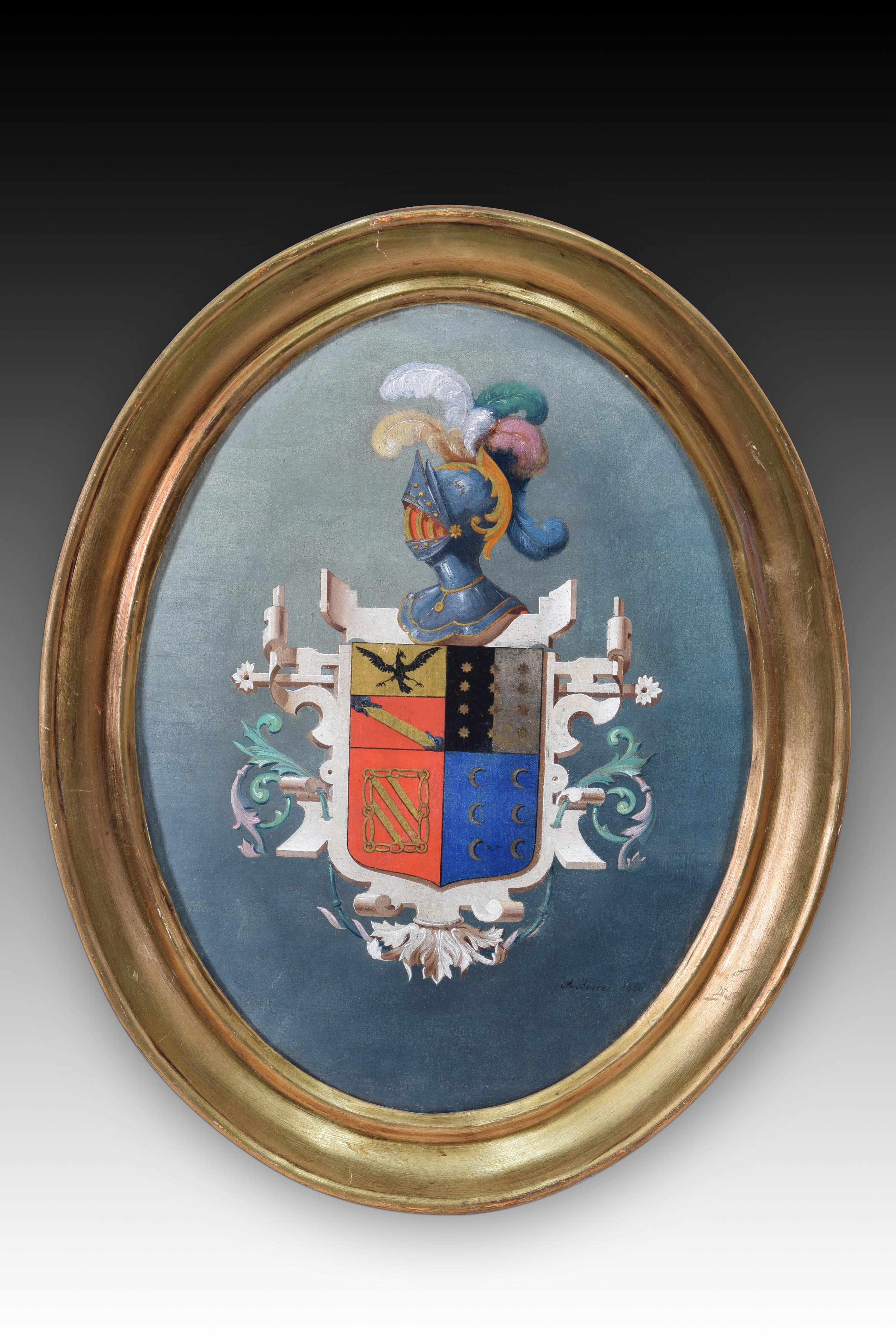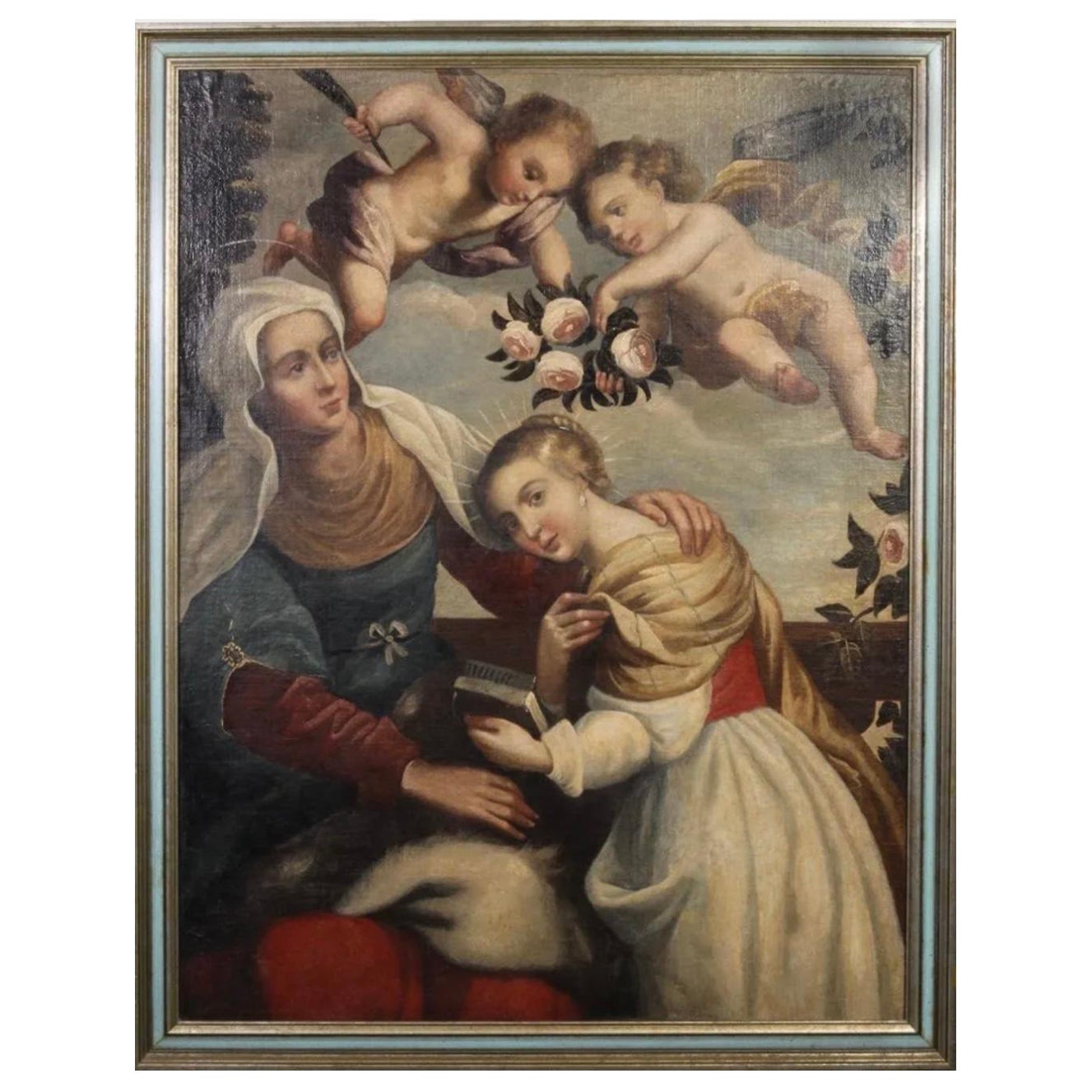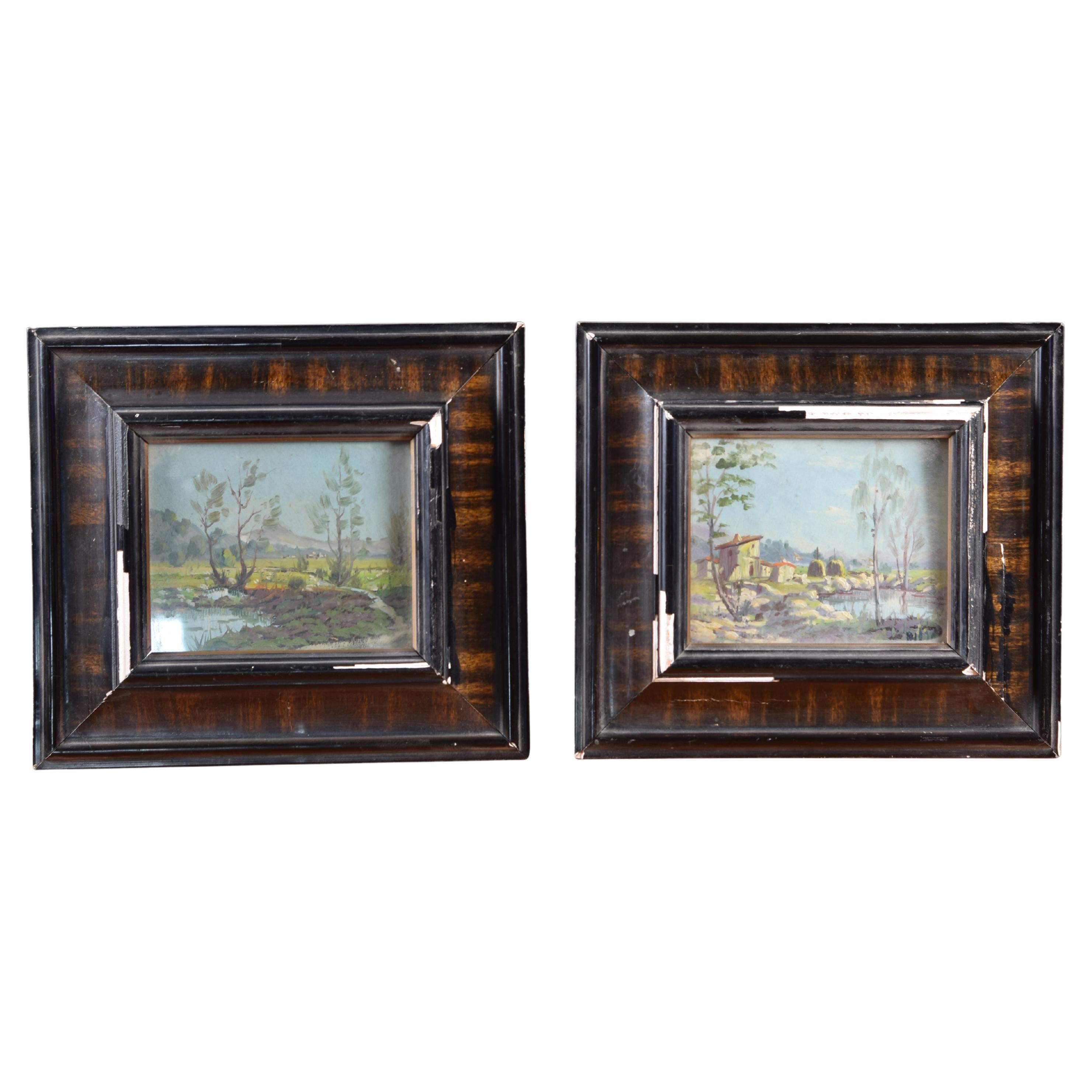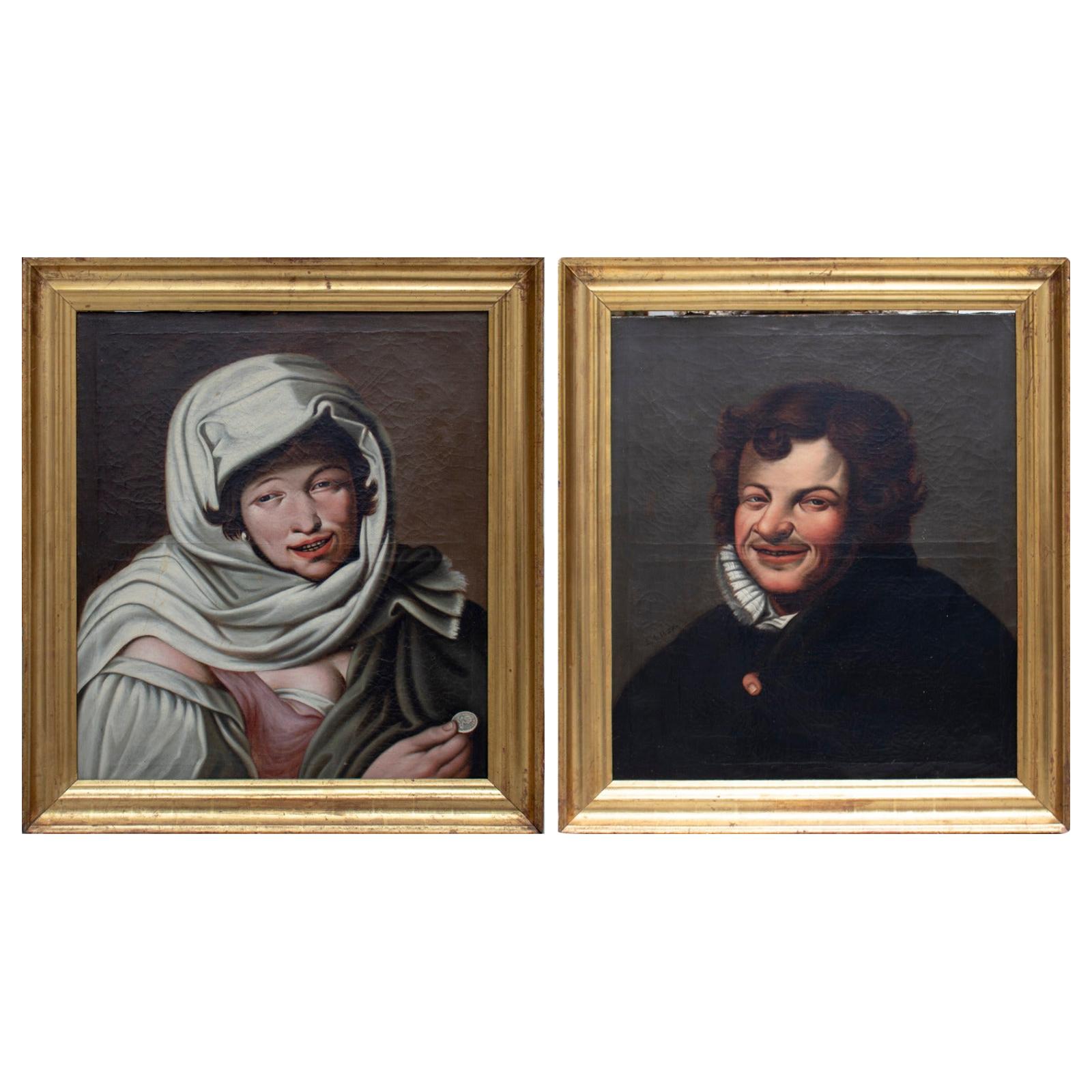Items Similar to "Wedding of Tethys and Peleus", Oil on Canvas, School of Madrid, Spain
Want more images or videos?
Request additional images or videos from the seller
1 of 9
"Wedding of Tethys and Peleus", Oil on Canvas, School of Madrid, Spain
About the Item
"Wedding of Tethys and Peleus". Oil on canvas. School of Madrid, 17th century. Corte, Juan de la (Antwerp, circa 1585 - Madrid, 1662) circle.
This work describes the weddings of the Nereid Thetis and the prince Peleo, parents of Achilles. It was celebrated on Mount Pelion, and all the deities came, although Eris, the goddess of discord, was not invited. In revenge, she threw a golden apple in which she said "for the most beautiful", that caused the dispute between Athena, Aphrodite and Hera that led to the Trial of Paris, to finally bring about the Trojan War. The banquet is depicted with a composition worked in depth, located in a rich interior of classical architecture illuminated by the light of Apollo, which is situated at the far end of the viewer. At the head of the table, in the foreground, appears Zeus, accompanied by the eagle and Hera, queen of the gods, to his left. In the lower right corner we see a group of satyrs serving the wine, accompanied by rich metal vessels worked with a detailed and descriptive brushstroke. The rest of the gods appear clearly differentiated, with Athena in the foreground to the right and, following an agile rhythm in zigzag, typically baroque, Aphrodite with Eros, Hermes and the grooms, to the left, and to the right Poseidon. Formally it is a work perfectly framed within the 17th century school of Madrid, developed around the court.
Thus, we see a sumptuous, allegorical classicist baroque, where the studies of light and color are especially relevant, revealing the exalted and luminous tone typical of this school's maturity. In particular, we can relate this painting to the circle of Juan de la Corte, painter of Flemish origin. We know nothing of his first formation today, for Palomino's assertion of his birth in Spain was documented, quoting in his testament that he was born in Antwerp. Also conserved documents in which the painter declares his apprenticeship in Flanders, where "it exerted his office by many years". For all this he has been associated with Flemish artists of the time who, due to personal knowledge or the study of his works, strongly influenced the configuration of his personal language. We know of his establishment in Spain at least since 1613. His work at the court encouraged him to ask for the place of royal painter who left vacant Bartolomé González in 1627, a goal he did not get. There is no documentary proof, therefore, that endorses the affirmation of Palomino when citing him like painter of the king. Nevertheless, it enjoyed a moderate success in the capital of the kingdom, being found his works in numerous noble inventories of the time. In turn, he enjoyed royal commissions, such as the cycle of biblical stories he painted for the Buen Retiro palace. His activity, according to his own confession, focused on "architectures, battles and countries", genres in which he was excellently valued by his contemporaries. One of the most interesting features of his style is the fact that he has often dealt with mythological subjects which, taken to the canvas in different cycles, offer us a singularly majestic panorama of a theme not frequent in the painting of Spain of the time. Another outstanding aspect of his work was the proliferation of architectural perspectives of evident linkage with the Nordic writers, most notably Vredeman de Vries. His pictorial style remained anchored in earlier traditions, demonstrating an obvious modesty and archaism, but the uniqueness of the issues he dealt made him worthy of the memory. Juan de la Corte is represented in the Museo del Prado, the Maritime of Barcelona, the Cerralbo and the Municipal of Madrid, among others .
· Size: 97 x 122 cm; 116 x 143 cm (marco). 7 cm (Depth).
- Similar to:Juan de la Corte (Artist)
- Dimensions:Height: 45.67 in (116 cm)Width: 56.3 in (143 cm)Depth: 2.76 in (7 cm)
- Style:Baroque (Of the Period)
- Materials and Techniques:
- Place of Origin:
- Period:
- Date of Manufacture:17th Century
- Condition:Wear consistent with age and use. Minor losses. Minor fading.
- Seller Location:Madrid, ES
- Reference Number:
About the Seller
4.9
Vetted Seller
These experienced sellers undergo a comprehensive evaluation by our team of in-house experts.
Established in 1985
1stDibs seller since 2017
292 sales on 1stDibs
Typical response time: 16 hours
- ShippingRetrieving quote...Ships From: Madrid, Spain
- Return PolicyThis item cannot be returned.
More From This SellerView All
- Heraldic Shield, Oil on Canvas, Torres, a. Spanish School, 1856Located in Madrid, ESHeraldic shield. Oil on canvas. TORRES, A. Spanish school, 1856. Signed and dated. This work shows a heraldic shield on a blue background with different tones, in an oval and fra...Category
Antique 1850s Spanish Neoclassical Revival Paintings
MaterialsOther
- Couple of landscapes. Oil on canvas. Spanish school (BILSO), 20th century.Located in Madrid, ESCouple of landscapes. Oil on canvas. Spanish school (BILSO), 20th century. Signed in the lower corners. Pair of landscapes or notes of rural landscapes with trees, mountains and bu...Category
20th Century Spanish Other Paintings
MaterialsOther
- Oil on Canvas, Martínez Novillo, Cirilo 'Madrid, 1921-2008'By Cirilo Martínez NovilloLocated in Madrid, ESSigned. Cirilo Martínez Novillo is one of the most outstanding representatives of the so-called School of Madrid, a city where he began his training at the School of Arts & Crafts. During the Civil War he entered the School of Painting and went to the workshop of Daniel Vázquez Díaz, who became his teacher, supporting him throughout his career. In his workshop, Martínez Novillo meets some of the painters linked to the School of Madrid: Álvaro Delgado...Category
20th Century Spanish Other Paintings
MaterialsCanvas
- Landscapes, Xalapa, Mexico, Pair of Oils on Canvas, Spanish School, Ca 1840Located in Madrid, ESLandscapes, Xalapa, Mexico. Pair of oils on canvas. Spanish school, around 1840. Provenance: Conde de la Cortina collection, Jalapa, Mexico. Couple of landscapes framed within the Spanish school of the first half of the 19th century, with a clear romantic affiliation. Both evidence the knowledge of the Dutch classicist landscape, one of the main influences on the Spanish romantic landscape. Thus, we see compositions in "V", closed on the sides and open in the center, very low horizons that allow a wide development of the sky, spaces built in depth based on successive planes subtly differentiated by light and color, and small figures perfectly integrated into the natural setting. In addition, the skies are scenographic and dramatic, with low clouds behind which the golden light characteristic of the classicist landscape filters. One of the most radical aspects of romantic painting was the attempt to replace large canvases with historical or religious themes with landscapes. They wanted the pure landscape, almost figureless or totally devoid of them, to achieve the heroic significance of history painting. They were based on the idea that human feeling and nature should be complementary, one reflected in the other. In other words, the landscape should arouse emotion and transmit ideas. Thus, landscapers like the author of these canvases tried to express their feelings through the landscape, instead of imitating it. The romantic landscape had two main aspects: the dramatic one, with turbulent and fantastic views, and the naturalistic one, which emphasized images of a peaceful and serene nature. This second conception is what we see embodied in these works; the painter tries to communicate a religious reverence for the landscape, nature in its fullness. In fact, the author's own use of light here conveys a foggy, cloudy, dreamlike atmosphere that invites the viewer to meditate and contemplate himself in the landscape. The romantic landscape is constituted, however, by manifestations of very different types and not comparable to each other; it does not affect all national schools equally, staying more faithful to tradition in schools such as the French or the Dutch. Thus, in this canvas we do not find the grandiose scenery of the British and Germans, the steep mountains or the monumental Gothic ruin...Category
Antique Mid-19th Century South American Neoclassical Revival Paintings
MaterialsOther
- Two Characters, Oil on Canvas, Martínez Novillo, Cirilo, SpainBy Cirilo Martínez NovilloLocated in Madrid, ES"Two characters". Oil on canvas. Signed (bottom right corner). MARTÍNEZ NOVILLO, Cirilo (Vallecas, Madrid, 1921 - Madrid, 2008). Cirilo Martínez Novillo was a painter from Madrid who began his training in the capital (School of Arts and Crafts, Libertarian Athenian of the People of Vallecas during the Civil War, School of Painting, Sculpture and Engraving at the National Library), starting at the time of the contest his first artistic works in the world of literature. When the war ended, he was imprisoned for a year, at which time he devoted himself completely to painting. In the 1940s he went from setting up his first studio and focusing his work on figures and still lifes, with his first solo exhibition in 1942, to be known by critics at the end of the decade; the 1950s were very important in his pictorial training, toured Spain and presented his work in several national and international exhibitions, in addition to being from these years when he fits within the "School of Madrid" (collectively presents many works together with others members of the same, such as Álvaro Delgado...Category
20th Century Spanish Other Paintings
MaterialsCanvas
- View of the pier of Antwerp. Oil on canvas. Flemish school, 18th century.Located in Madrid, ESView of the pier of Antwerp. Oil on canvas. Flemish school, 18th century. Numerous ships and boats appear in the landscape, accompanied by small characters. In the background a city...Category
Antique 18th Century European Neoclassical Paintings
MaterialsOther
You May Also Like
- European School Oil on Canvas of 20th CenturyBy EuropaLocated in Madrid, ESEuropean school oil on canvas of 20th century Measures: 72 x 62 cm and 39 x 30 cm Good condition.Category
20th Century Spanish Baroque Paintings
MaterialsPaint
- Spanish Colonial 18th Century Cuzco School Oil on CanvasLocated in Bradenton, FLA traditional and characteristic 18th century, Spanish colonial oil on canvas painting depicting the Virgin Mary holding a book with St. Anne an...Category
Antique 18th Century Peruvian Spanish Colonial Paintings
MaterialsCanvas, Paint
- 19th Century Pair of Spanish Murillo School Oil on Canvas PortraitsLocated in Marbella, ES19th-century pair of signed Spanish Murillo school oil on canvas portraits. Dimensions with frame: 61 x 54.5 x 4.5cm.Category
Antique 19th Century Spanish Paintings
MaterialsCanvas
- Colonial Spanish oil on canvas " Saint Rose of Lima"By Colonial Furniture CompanyLocated in Valladolid, ESOne of a kind oil on canvas made in the 18th century depicting Saint Rose of Lima with the Child Jesus, Colonial School of the Viceroyalty of Peru. The Sa...Category
Antique 1780s Peruvian Baroque Paintings
MaterialsCanvas, Wood, Paint
- Cuzco School Oil Painting on Canvas of the Holy FamilyLocated in Hastings, GBAn exceptional early Cuzco School painting, naive depiction of the Holy Family, presented in a contemporary wooden frame. The Cuzco or Cusco school was a Roman Catholic artistic tradition that began in the 1500's in Peru, following the Spanish conquest and subsequent attempts by the Spanish invaders and missionaries to implement the Catholic faith and associated customs upon the Peruvian people. The school was established in the ancient city of Cusco which had previously been the capital of the Incan empire. Bernardo Bitti arrived in Peru in 1583, and with his arrival the acceleration of Cuzqueno Art flourished. During his two stays in Cusco, Bitti was commissioned to make the main altarpiece of the church of his Order, replaced by another after the earthquake, and painted some masterpieces, such as The Coronation of the Virgin, currently in the museum of the church of La Merced, and the Virgen del pajarito, in the cathedral. Cuzco School paintings are marked by their baroque influenced imagery and the subjects of the paintings shown with light focused upon them. Cuzco art...Category
20th Century Peruvian Baroque Paintings
MaterialsCanvas
- 19th Century Oil on Canvas José Mirailles Darmanin Spanish SchoolBy Joseph DarmaninLocated in Marseille, FR19th century José Mirailles Darmanin (1850-1900) Spanish school the gentleman (and his servant) takes the meal. Genre scene.Category
Antique 19th Century French Paintings
MaterialsCanvas
Recently Viewed
View AllMore Ways To Browse
Excellent Values
Oil Canvas Baroque
Head Of Hermes
Cites Hermes
Hermes Cites
Spanish 17th Table
17th Century Spanish Table
Antique Style Wedding
Spanish 17th Painting
Hermes Decoration
Flemish School Oil
Spanish 17th Century Painting
17th Century Spanish Painting
Spanish Baroque Frame
Spanish Baroque Painting
Antique Banquet
King Of Spain
Antique Wedding Frames





